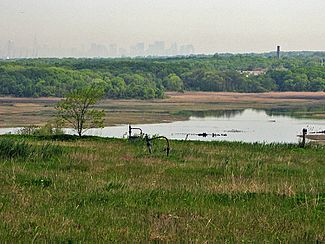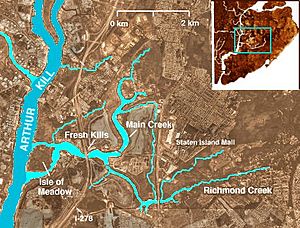Freshkills Park facts for kids
Quick facts for kids Freshkills Park |
|
|---|---|

View of Freshkills Park in 2010
|
|
| Type | Public park |
| Location | Fresh Kills Landfill site, Staten Island, New York City, United States |
| Nearest city | New York City |
| Area | 2,200 acres (8.9 km2) |
| Created | 2008 |
| Operated by | New York City Department of Parks and Recreation |
| Open | 2012 (partial) 2035–37 (full) |
Freshkills Park is a huge public park being built on Staten Island in New York City. What makes it special is that it's being created on top of a former landfill, which is a place where trash was once dumped. This park will be about 2,200 acres (8.9 km2) big. That's almost three times the size of Central Park!
Building Freshkills Park started in 2008 and will continue in different stages until around 2035–2037. When it's finished, it will be the second-largest park in New York City. The park is designed to be a fantastic place with open grassy areas, waterways, and special structures. It will have many different spaces for fun activities, learning, and playing. Paths for walking and biking will connect different parts of the park. The New York City Department of Parks and Recreation is in charge of this amazing project.
Contents
Park History
From Landfill to Park
The area where Freshkills Park is now used to be a salt marsh and farmland. In 1948, it became a landfill, a place where New York City's garbage was taken. The ground there had clay, sand, and silt, along with wetlands and forests. At that time, people didn't fully understand how important wetlands were for protecting against storms and cleaning water.
The original idea was to fill the land with trash for only three years. Then, it would be turned into a place with homes, parks, and businesses. But New York City's population grew, and so did its trash. It was easy to keep expanding the landfill on Staten Island. So, three years turned into fifty! From 1948 to 2001, the landfill accepted garbage. By 1955, it was the largest landfill in the world. At its busiest, twenty barges, each carrying 650 tons of garbage, arrived every day.
People on Staten Island tried many times to close the landfill. Finally, in 1996, rules were passed to close it by 2001. It was estimated that if it stayed open, it would have become the highest point on the East Coast. With strong support from the community and the United States Environmental Protection Agency (EPA), the landfill officially closed on March 22, 2001.
However, it had to reopen briefly after the tragic events of September 11, 2001. Materials from the World Trade Center site were brought to the landfill. Many experts worked tirelessly to examine these materials and recover important items. After this important work was done, the landfill was permanently closed. This cleared the way for the park to be built.
Designing the Park
In 2001, the New York City Department of City Planning held a worldwide competition. They wanted to find the best design for the new park. Many talented landscape architecture firms submitted their ideas. In August 2001, six proposals were chosen as finalists.
In 2003, a firm called James Corner Field Operations won the competition. They were hired to create a detailed plan for how the park would be developed over many years. This plan, called the Draft Master Plan, was released in 2006. Later, in 2006, the NYC Parks became the main agency in charge of developing the park.
Park Planning
The Master Plan
The 2006 Draft Master Plan for Freshkills Park imagined the site as five parks in one. Each area would have its own unique feel and activities. This plan was created with ideas from meetings and workshops. Many people, including Staten Islanders, local groups, and government officials, shared their thoughts.
Some of the main goals included:
- New roads to help with traffic around the park.
- Fun activities like kayaking, horseback riding, and sports fields.
- Projects that create and use clean energy, like solar power.
A group of local leaders also helped with the planning process.
The five main areas planned in the park are:
- North Park: This 223-acre area will stay mostly natural. It will help expand the nearby William T. Davis Wildlife Refuge. North Park will be great for wildlife and quiet activities like walking, biking, and hiking on trails.
- South Park: This 425-acre section also has natural woodlands and wetlands. But it also has flat, open spaces for more active fun. The plan suggested tennis courts, trails, sports facilities, and even a place for horse riding.
- East Park: This 482-acre area was planned for meadows, trails, playing fields, and picnic spots. A golf course was also suggested to help earn money for the park's operations. There's also a plan for a road system to connect Richmond Avenue and the West Shore Expressway through East Park.
- West Park: After the September 11 attacks, about 1.1 million tons of materials from the World Trade Center were brought here. These materials were carefully checked and sorted. The search continued until all important items were removed. The Department of Sanitation is still working on covering and closing this area.
- The Confluence: This 70-acre area is where the park's two creeks meet. It's planned to be the main hub of the park. It will have visitor centers, restaurants, a marina, and spaces for events and quiet relaxation. You might even be able to get there by boat, using the same waterways that once brought barges of trash.
Building the Park: Early Projects
Building a park on a former landfill is a big job. It involves many steps and permits from city and state agencies. This ensures that the landfill's structures and the growing natural areas are protected. NYC Parks started building around the edges of the park first. This showed local communities that the city was serious about transforming the landfill. It was also easier to get permits for these outer areas.
Some of the first projects include:
- Schmul Park: The first project was renovating Schmul Park in the Travis neighborhood. It was finished in 2012. This old playground was turned into a modern park with new play areas, basketball and handball courts, and native plants.
- Owl Hollow Soccer Fields: Next, NYC Parks built the Owl Hollow Soccer Fields. These are on the southeastern side of the park, near Arden Avenue and Arthur Kill Road. This project, completed in 2013, includes four new AstroTurf fields, two of which are lit for night games, plus a circular path and parking.
- New Springville Greenway: In 2015, NYC Parks finished building the New Springville Greenway. This is a new path for bikes and walkers that runs along the edge of Richmond Avenue.
- North Park Phase 1: In 2017, work began on North Park Phase 1. This 21-acre path starts at the park entrance and offers great views of the creeks. It will include a composting restroom, a bird-watching tower, and a wetland viewing deck. This path also connects to Schmul Park. This phase is expected to be complete in 2021.
- South Park Anchor Park: In 2016, $30 million was set aside for Freshkills Park as part of the city's Anchor Parks program. The South Park Anchor Park project is currently being designed. It will include walking paths, two multi-purpose fields, a restroom, and parking. The design is expected to be finished in November 2020.
Solar Energy Plans
In 2012, New York City asked companies to propose building solar or wind energy facilities at Freshkills Park. A company called SunEdison was chosen in 2013 to build solar arrays. However, SunEdison went out of business in 2016. Since then, no further work has been done on placing renewable energy projects at Freshkills Park.
Park Wildlife
Even though the park is still being built, it's already home to many different kinds of animals and plants. In 2015, a special event called a BioBlitz found 320 species of plants and animals in just 24 hours! Scientists are studying how wildlife changes as the site transforms from a landfill into a green space.
Current research projects include:
- Monitoring fish populations.
- Studying grassland habitats.
- Banding migratory birds.
- Monitoring grassland birds.
- Monitoring bat populations.
Over 200 species of birds have been seen at the park. Some nest there, while others stop during migration, hunt, or look for food. Freshkills Park is now home to the largest group of nesting Grasshopper Sparrows in New York State. These sparrows are a special concern species and started nesting at the park in 2015.
Common wildlife you might find at Freshkills Park includes:
- Birds like Red-winged Blackbirds, American Goldfinches, Red-tailed Hawks, American Kestrels, Osprey, Ring-necked Pheasants, Tree Swallows, Turkey Vultures, Northern Harriers, Savannah Sparrows, and American Woodcock.
- Mammals like white-tailed deer, muskrat, and red foxes.
- Reptiles like northern snapping turtles and diamondback terrapins.
Park Programs and Activities
While Freshkills Park is still being developed, NYC Parks and the Freshkills Park Alliance host many events and programs. These often take place in areas of the park that are usually closed to the public.
The park opens to the public twice a year for special Discovery Days in the spring and fall. On these days, visitors can kayak, bike, hike, and fly kites in a closed section of the park. The Freshkills Park Alliance also runs educational and public programs. These include kayaking, cycling, and running events, citizen science projects, art projects, tours, and field trips. Starting in 2020, Freshkills Park also began offering virtual field trips and online programs. The Freshkills Park office often works with cultural and academic groups on Staten Island and in NYC for these programs.
Landfill Operations and Safety Rules
The Fresh Kills Landfill received New York City's trash from 1947 to 2001. Two of the four large mounds of trash at the site, called North and South mounds, were covered with a special waterproof layer in the late 1990s. This layer keeps the trash separate from the environment. Covering the East Mound, which will become East Park, started in 2007 and finished in 2011. Covering the West Mound began in 2011 and is expected to be done in 2022.
The Department of Sanitation works with the New York State Department of Environmental Conservation (NYSDEC). They make sure the landfill closure follows all environmental rules. They will also continue to monitor the site and maintain control systems even after the park opens. NYC Parks must also follow NYSDEC's rules. No part of the park can open to the public until it meets state safety standards.
NYC Parks released a detailed report in May 2009 about the environmental effects of the Freshkills Park project. This report looks at all possible impacts on the nearby community. It helps identify any negative effects and suggests ways to prevent or reduce them. Another report was completed in October 2009, specifically looking at the impact of proposed roads through the East Park section. These environmental studies are updated for each project phase. This ensures that any new environmental impacts are found and addressed.


